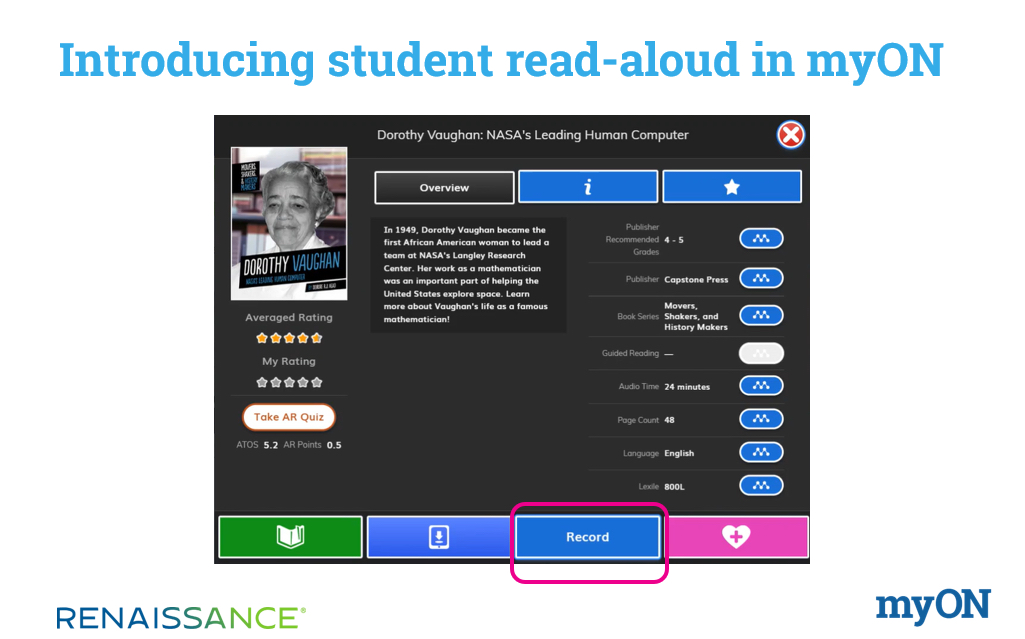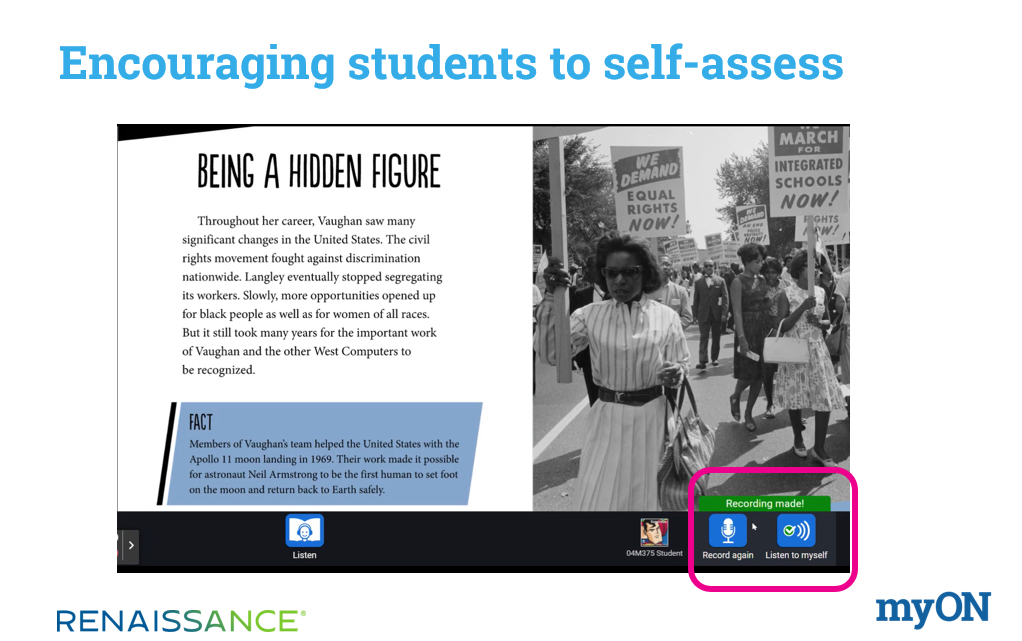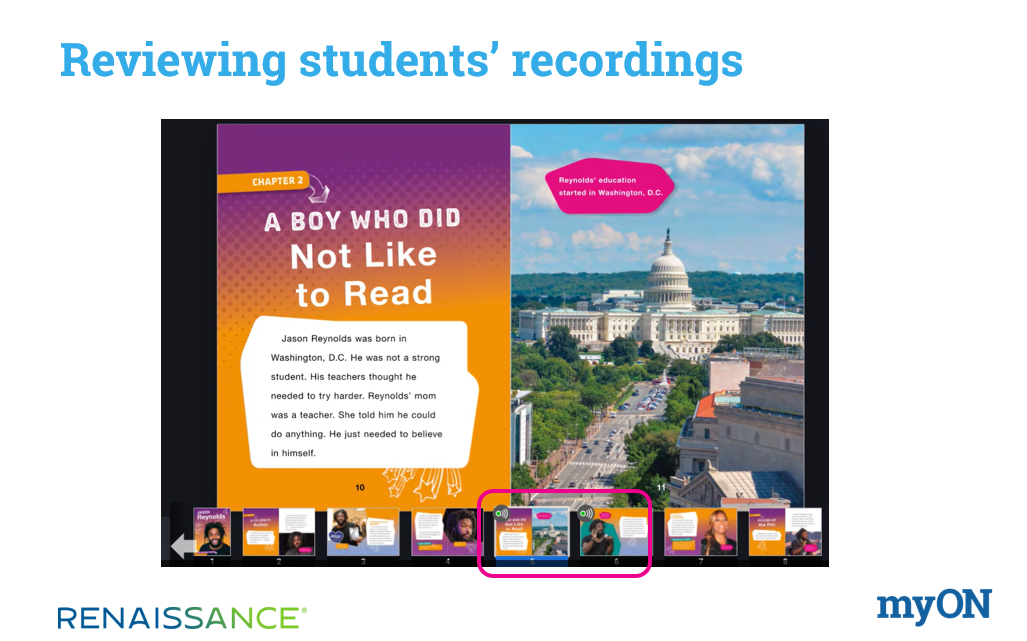May 27, 2022
The myON digital reading platform provides students with 24/7 access to thousands of fiction and nonfiction books. Most myON texts include natural-voice audio narration to model fluent reading. With Back-to-School 2022, myON will also allow students to record themselves reading aloud—and to easily review the recording before they submit it to their teacher.
We recently had the opportunity to discuss this new feature with our colleagues Susannah Moran, Senior Project Manager; Kate Cowell, Product Manager; and Dr. Scott McConnell, Director of Assessment Innovation. Highlights from our conversation appear below.
Questions and answers
Why are we adding the new student read-aloud feature to myON? How will it support reading development and reading growth?
Susannah Moran: This is a longstanding request from educators. In the elementary grades, having students read aloud is standard practice in every classroom, and many teachers use running records to monitor oral reading fluency. While having this data is important, it’s not the same as having actual recordings. Recordings allow teachers to create reading portfolios, to compare how students read at the beginning of the school year to how they read at the end of the year. Recordings also allow students to listen to themselves, so they can hear both their miscues and their strengths as readers.
I’ve also received requests for this feature from instructional coaches in middle schools. They feel that—due to all of the demands on instructional time—students aren’t given enough opportunity to read aloud and to then self-assess their reading. Technology can really help here, by giving students the ability to both record themselves and self-assess outside of class time.
Kate Cowell: We interviewed a number of educators as we were designing this new feature. As Susannah mentioned, many said they didn’t have enough class time to give every student the opportunity to read aloud as often as they’d like. They also mentioned students who don’t want to read in front of their peers—perhaps because they’re struggling readers, or because they dislike being the center of attention.
This new feature addresses both of these points. It preserves instructional time by giving students the ability to record themselves in the evening or on weekends. It also gives students greater control over the environment, so they can read aloud without having an audience, if that’s their preference. Our goal here isn’t to create a formal assessment of oral reading fluency but rather to give students additional opportunities for reading practice, so we want to make this new feature as flexible as possible
Susannah Moran: I know I’m “dating” myself, but when I taught reading in middle school, I had a Sony tape recorder I used during read-alouds. I’d then have students listen to the recording, and I’d ask open-ended questions about the reading choices they’d made. All readers occasionally make substitutions when reading a text, or skip words, or add words that aren’t there. Sometimes these changes affect the text’s meaning, and sometimes they don’t. In either case, I noticed that students often had more confidence in themselves as readers after listening to the recording, and they were more willing to talk about their reading.
The new feature in myON takes this a step further, by giving students the ability to review the recording before they turn it in. If they’re not happy with it, they have the option to re-record it. The opportunity to self-assess in this way—to make students the decision-makers—is really powerful, and gives them greater ownership of their reading.

What does the research say about oral reading practice and giving students opportunities to self-assess?
Scott McConnell: Most of the research on oral reading practice is “synchronous,” focusing on what happens when a teacher, librarian, or other adult reads aloud to students. The findings are quite consistent: reading aloud to students expands their vocabulary and knowledge, while also providing important models of expression and prosody. The research also shows that having students read aloud to other students and their teacher, followed by feedback and discussion, contributes to reading fluency and to a better understanding of the text being read. This new feature in myON provides additional ways of achieving these outcomes.
How so? First, myON’s natural-voice audio narration provides each student with a model of fluent, expressive reading of the text they have selected. Until now, this type of modeling usually occurred only when a teacher read to small groups or a whole class—a great resource, but one where student selection of content (and, as a result, perhaps their interest in it) is restricted. Second, students can now listen to their own reading of the same text, both in real time and after completing their read aloud. In each instance, students have opportunities to “check their work” by looking at the words being read or by determining whether the text makes sense in their read aloud. When necessary, they can back up and re-read a section to reflect their self-correction:

This new feature also allows students and teachers to interact in new ways, at both the “micro” and “macro” levels. After listening to a student’s recording, the teacher can provide instruction or correction on decoding or mispronunciation, and can praise the student for improved expressive reading. Teachers can also engage students in what they’ve read, checking for understanding and asking questions that deepen a student’s analysis and comprehension of a text. In this way, myON adds breadth to a teacher’s reach, by providing opportunities for students to read aloud more frequently. At the same time, myON adds greater depth to a teacher’s reach through follow-up interactions with students about their reading selections.
How will this new feature work? What will students and teachers see?
Kate Cowell: We designed the student read-aloud feature to be as intuitive and user-friendly as possible. Students can start the recording at either the beginning of a myON book or from any page within a book. When they click the “Record” button, they’ll receive a pop-up message to allow myON to access their microphone. When they’re done recording, they’re given the option to listen to it immediately. They can then submit it to the teacher, record it again, or save it for later.
Students can access their recordings at any time by clicking myON’s Library tab and then navigating to the Recordings tab. Recordings are organized into two groups: those they’ve turned in and those that are still in progress. They simply open any of the myON books listed, and they’ll see icons indicating which pages have associated recordings. To listen, they just click the icon:

Teachers will see a new tab on their Activity Dashboard for their students’ recordings. For each recording, they’ll see the student’s name, the book’s title, and the recording’s date, length, and status (either In Progress or Turned In). When teachers listen to a recording, they see a view nearly identical to the one shown above—so they can easily see the myON book, with icons to indicate which pages have the student’s recorded read-aloud.
Susannah Moran: To echo Kate’s point about ease-of-use, one of the schools I work with had volunteered to help us test this new feature, and the capability was added during a recent vacation. Without any prompting or instructions, several students noticed the new feature while they were reading on myON at home, and they recorded themselves reading aloud. The teachers were surprised to find that they had recordings waiting for them when they returned to the school building!
How might districts use the student read-aloud feature during the 2022–2023 school year? What guidance can we provide?
Susannah Moran: We’re gaining a lot of insight during the current user testing, which will inform our resources and best practices for educators. As I mentioned earlier, elementary reading teachers are already doing fluency instruction (such as guided oral reading) and formative assessment (such as running records), although they’re not necessarily using technology for this. As Scott noted, myON brings the added benefit of natural-voice audio narration, so students can hear the text read fluently and hear the pronunciation of unfamiliar words. In the early grades especially, students might listen to the audio narration first and then record themselves reading the same passage. This provides an opportunity to practice different elements of fluency—tone, pace, pronunciation—while also helping students to build confidence as readers.
I’d also ask high school teachers to give this feature a look. myON includes many titles taught in high school: The Great Gatsby, Frankenstein, Narrative of the Life of Frederick Douglass, Hamlet, and more. Asking students to read Shakespeare aloud certainly shows you whether they understand it, based on their tone, where they pause for breath, etc. It also emphasizes the importance—at every grade level—of regular reading practice. Fluent reading doesn’t just happen. It’s something that students have to practice in order to be good at.
Kate Cowell: That’s such an important point. We also know that myON is used by students who are learning English, both in the US and around the world. myON’s natural-voice audio is especially helpful for these learners, because it models English pronunciation and fluent reading while also helping them to build their listening vocabulary. The new read-aloud feature will take this a step further, by allowing English Learners to easily listen to themselves and to assess their pronunciation, pace, and tone. The recordings will also be valuable to teachers, to help them monitor students’ practice and progress.
There’s a lot more to say about this—I think we have a topic for a future blog!
Scott McConnell: In my experience, a district’s reading program has two complementary goals: first, to help students improve their reading skill, and second, to help them develop a passion for the discovery that comes from reading. For a long time, myON has served both of these goals, but with a “lean” towards tools that help students choose books that reflect and in turn fuel their interests. The new read-aloud feature maintains this “choose your own adventure” aspect of myON, while also adding more ways for students and teachers to interact about the text each student is reading and how that text relates to their growing knowledge of the world around them.
This new feature also makes it possible to accumulate portfolios of student oral reading over the course of an academic year, as Susannah noted earlier. I imagine this will be a helpful feature for teachers, students, and even students’ families. They can now have access to a “moving picture” of the student’s growing competence as the year progresses. This portfolio has formal value too, providing teachers with a pre-established library for monitoring and describing the progress each student makes in both the fundamentals of reading and its application to understanding and learning.
This step toward motivating more independent reading while providing new opportunities for teacher-student interaction will be an important resource for achieving both of these goals in the new school year.
Explore myON
Discover how to expand your district’s myON digital library with add-on publishers’ collections focused on phonics, STEM, social-emotional learning, world languages, and more. If you’re not already using myON, click the button below to get started.

